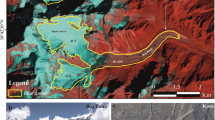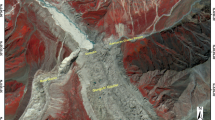Abstract
Snout monitoring of the Gangotri glacier (Uttarakhand, India) during the ablation season (May to September) in years 2005 and 2015 by using rapid static and kinematic GPS survey reveals that the retreating rate has been comparatively more declined than shown by the earlier studies. Our study is based on the individual measurement by the remote sensing, added by the ground observations by using Differential global positioning system (DGPS) to determine the precise recession rate of the glacier at sub-centimeter level of accuracy. The GPS dataset show that the total average retreat along the snout has been 102.57 ± 0.05 m from 2005 to 2015 with an average rate as 10.26 ± 0.05 m/yr. Additionally, the shift in snout position was also measured through multi-temporal satellite data from 1989 to 2016. The results indicate that the Gangotri glacier snout has retreated by 585.62 ± 38.30 m during this period with an average retreat of 26.75 ± 4.36 m/yr from 1989 to 1999, 21.58 ± 3.77 m/yr from 1999 to 2009 and 14.60 ± 4.81 m/yr from 2009 to 2016. Such a decline in retreat is further confirmed by the satellite data set. A close examination of meltwater discharge and retreating rate (r2 = 0.95) show that both parameters are strongly correlated. Therefore, we suggest that a consistent decrease in meltwater discharge from 1999 to 2015 is in agreement with decreasing trend of retreating rate during the recent years. To determine the possible causes of decreased retreating rate, a relationship between debris thickness and melt rate was also established by ablation stakes. Further, we infer that the declining trend in the glacier retreat is not only controlled by prevailing weather conditions (rainfall and air temperature) but is also governed by increased debris cover on the glacier surface which prevents the ice to melt.







Similar content being viewed by others
References
Ali SN, Singh R, Pandey P (2019) Estimation of the frontal retreat rate of the Pindari glacier, Central Himalaya using remote sensing technique. Earth Sci India 12(3):146–157. https://doi.org/10.31870/ESI.12.3.2019.11
Bahuguna IM (2003) Satellite stereo data analysis in snow and glaciated region. Training document: Course on remote sensing for glaciological studies. Manali, India, SAC/RESA/MWRG/ESHD/TR/13/2003, pp 85–99
Bali R, Agarwal KK, Ali SN, Rastogi SK, Krishna K (2009) Monitoring recessional pattern of Central Himalayan Glaciers: some optimistic observations. Proc Ind Sci Cong 96:79–80
Bali R, Awasthi DD, Sharma AK, Tewari NK (2003) Neotectonic control of the geomorphological evolution of Gangotri glacier valley. Garhwal Himalaya Gond Res 6(4):829–838. https://doi.org/10.1016/S1342-937X(05)71028-5
Benn DI, Bolch T, Hands K et al (2012) Response of debris-covered glaciers in the Mount Everest region to recent warming, and implications for outburst flood hazards. Earth Sci Rev 114(1–2):156–174. https://doi.org/10.1016/j.earscirev.2012.03.008
Bhambri R, Bolch T, Chaujar RK (2011) Frontal recession of Gangotri glacier, Garhwal Himalaya, from 1965 to 2006, measured through high resolution data. Curr Sci 102(3):489–494
Bhattacharya A, Bolch T, Mukherjee K, Pieczonka T, Kropacek J, Buchroithner MF (2016) Overall recession and mass budget of Gangotri glacier, Garhwal Himalayas, from 1965 to 2015 using remote sensing data. Jour Glaciol 62(236):1115–1133. https://doi.org/10.1017/jog.2016.96
Bisht H, Arya PC, Kumar K (2018) Hydro-chemical analysis and ionic flux of meltwater runoff from Khangri Glacier, West Kameng, Arunachal Himalaya. India Environ Ear Sci 77:598. https://doi.org/10.1007/s12665-018-7779-6
Bisht H, Kotlia BS, Kumar K, Arya PC, Sah SK, Kukreti M, Chand P (2020) Estimation of suspended sediment concentration and meltwater discharge draining from the Chaturangi glacier Garhwal Himalaya. Arab J Geosci 13:248. https://doi.org/10.1007/s12517-020-5204-4
Bisht H, Rani M, Kumar K, Sah S, Arya PC (2019) Retreating rate of Chaturangi glacier, Garhwal Himalaya, India derived from kinematic GPS survey and satellite data. Curr Sci 116:304–311. https://doi.org/10.18520/cs/v116/i2/304-311
Bisht H, Sah S, Kumar K, Arya PC, Tewari M (2017) Quantification of variability in discharge and suspended sediment concentration of meltwater of Gangotri glacier, Garhwal Himalaya. ENVIS Bull Him Ecol 25:10–16
Dimri AP, Yasunari T, Kotlia BS, Mohanty UC, Sikka DR (2016) Indian winter monsoon; present and past. Earth Sci Rev 163:297–322
Dobhal DP, Mehta M, Srivastava D (2013) Influence of debris cover on terminus retreat and mass changes of Chorabari Glacier, Garhwal region, central Himalaya. India J Glaciol 59(217):961–971. https://doi.org/10.3189/2013/JoG12J180
Dumka RK, Kotlia BS, Miral MS, Joshi LM, Kumar K, Sharma AK (2013) First GPS derived recession rate in Milam glacier, higher central Himalaya, India. Intern J Eng Sci 2:58–63
Hall DK, Bahr KJ, Shoener W, Bindschadler RA, Chien JYL (2003) Consideration of the errors inherent in mapping historical glacier positions in Austria from the ground and space. Rem Sen Environ 86:566–577. https://doi.org/10.1016/S0034-4257(03)00134-2
Hubbard B, Glassar N (2005) Field techniques in glaciology and glacial geomorphology. John Wiley & Sons Ltd, England
Jangpangi BS (1958) Report on the survey and glaciological study of the Gangotri glacier, Tehri Garhwal District: Glacier No. 3, Arwa Valley: Satopanth and Bhagirath Kharak Glaciers, Garhwal District, Uttar Pradesh. Mem Geol Surv India, p 18
Karpilo RD (2009) Glacier monitoring techniques. In: Young R, Norby L (eds) Geological monitoring. Geol Soc Amer, Boulder, pp 141–162
Kaser G, Fountain A, Jansson P (2003) A manual for monitoring the mass balance of mountain glaciers. UNESCO Paris 59:107 (IHP-VI Technical Documents in Hydrology)
Kaul MK (1999) Inventory of Himalayan Glaciers. Geol Surv India 34:136–137
Kirkbride M (1995) Ice flow vectors on the debris-mantled Tasman Glacier 1957–1986. Geografiska Ann Ser A Physl Geogr 77(3):147–157. https://doi.org/10.1080/04353676
Kochtitzky W, Winski D, McConnell E et al (2019) The impact of climate on surging at Donjek glacier, Yukon, Canada. Cryosphere 72:1–31. https://doi.org/10.5194/tc-2019-72
Kotlia BS, Singh AK, Joshi LM, Bisht K (2018) Precipitation variability over Northwest Himalaya from ~4.0 to 1.9 ka BP with likely impact on civilization in the foreland areas. J Asian Earth Sci 162:148–159
Kulkarni AV, Bahuguna IM, Rathore BP et al (2007) Glacial retreat in Himalaya using Indian Remote Sensing satellite data. Curr Sci 92(1):69–74
Kumar K, Dumka RK, Miral MS, Satyal GS, Pant M (2008) Estimation of retreat rate of Gangotri glacier using rapid static and kinematic GPS survey. Curr Sci 94(2):258–262
Kumar K, Miral MS, Joshi V, Panda YS (2002) Discharge and suspended sediment in the meltwater of Gangotri Glacier, Garhwal Himalaya. India Hydrol Sci J 47(4):611–619. https://doi.org/10.1080/02626660209492963
Majeed Z, Mukhtar MA, Mir RA, Kumar P, Krishna K (2020) Sonapani glacier recession over a century from 1906–2016, Chandra basin, Himachal Himalaya. J Geol Soc India 95:36–44. https://doi.org/10.1007/s12594-020-1384-5
Metcalfe RP (1993) Pressure, temperature and time constraints on metamorphism across the MCT zone of High Himalaya slab in the Garhwal Himalaya. In: Treloar RJ, Searle MP (eds) Himalaya Tectonics. Geol Soc, London, pp 495–509
Nainwal HC, Negi BDS, Chaudhary M, Sajwan KS, Gaurav A (2008) Temporal Changes in rate of recession: evidence from Satopanth and Bhagirath Kharak Glacier, Uttarakhand, using total station Survey. Curr Sci 94(5):653–660
Naithani AK, Nainwal HC, Sati KK, Prasad CP (2001) Geomorphological evidences of retreat of Gangotri glacier and its characteristics. Curr Sci 80:87–94
Negi HS, Thakur NK, Ganju A (2012) Monitoring of Gangotri glacier using remote sensing and ground observations. J Earth Sys Sci 121(4):855–866. https://doi.org/10.1007/s12040-012-0199-1
Østrem G, Brugman M (1991) Glacier mass-balance measurements: a manual for field and office work. National Hydrology Research Institute, Environment Canada, Saskatoon, Sask, (NHRI Science Report 4), Water Resources and Electricity Board, Oslo, p 224
Pratap B, Dobhal DP, Mehta M, Bhambri R (2015) Influence of debris cover and altitude on glacier surface melting: a case study on Dokriani Glacier, central Himalaya. India Ann Glaciol 56(70):9–16. https://doi.org/10.3189/2015/AoG70A971
Pudełko R, Angiel PJ, Potocki M, Jedrejek A, Kozak M (2018) Fluctuation of glacial retreat rates in the Eastern part of Warszawa icefield, King George Island, Antarctica, 1979–2018. Remote Sens 10(892):2–25. https://doi.org/10.3390/rs10060892
Puri VMK, Singh (1974) Report on Gangotri Glacier. Report to Geological Survey of India (Unpublished)
Puri VMK (1984) Gangotri Glacier-report on the Interdepartmental Expedition-1975. (Progress Report) Rep. Geological Survey of India (Unpublished)
Puri VMK, Shukla SP (1991) Tongue fluctuations studies on Gangotri glacier, Uttarkashi district, Uttar Pradesh. Geol Surv India, Sp Publ No 21(2):289–291
Raina VK, Srivastava D (2008) Glacier Atlas of India. Geological Society of India, Bangalore
Sangewar CV (1997) Report on glacier front fluctuation in parts of H.P. and U.P. Geological survey of India (Unpublished)
Scherler D, Bookhagen B, Strecker MR (2011) Spatially variable response of Himalayan glaciers to climate change affected by debris cover. Nat Geosci 4(3):156–159. https://doi.org/10.1038/ngeo1068
Shroder JF, Bishop MP, Copland L, Sloan VF (2000) Debris covered glaciers and rock glaciers in the Nanga Parbat Himalaya, Pakistan. Geogr Annal Ser A Phys Geogr 82(1):17–31. https://doi.org/10.1111/j.0435-3676.2000.00108.x
Shukla P, Siddiqui MA (2001) Recession of the snout in front of Milam glacier, Goriganga valley, Pithoragarh district, Uttar Pradesh. Geol Sur Ind Spec Pub 53:71–75
Singh DS, Tangri AK, Kumar D, Dubey CA, Bali R (2017) Pattern of retreat and related morphological zones of Gangotri glacier, Garhwal Himalaya India. Quat Int 144:172–181. https://doi.org/10.1016/j.quaint.2016.07.025
Singh P, Haritashya UK, Kumar N (2008) Modelling and estimation of different components of stream flow for Gangotri glacier basin Himalayas. Hydrol Sci J 53(2):309–322. https://doi.org/10.1623/hysj.53.2.309
Singh P, Haritashya UK, Kumar N, Singh Y (2006) Hydrological characteristics of the Gangotri Glacier, central Himalayas, India. J Hydrol 327:55–67. https://doi.org/10.1016/j.jhydrol.2005.11.060
Sinha LK, Shah A (2008) Temporal analysis of Siachen Glacier: a remote sensing perspective. In: Nat. Sem. Glacial Geomorphology and Paleoglaciation in Himalaya, pp 43–44
Srivastava D (2004) Recession of Gangotri glacier. Geol Surv India 80:21–32
Srivastava D, Kumar A, Verma A, Swaroop S (2012) Characterization of suspended sediment in meltwater from glaciers of Garhwal Himalaya. Hydrol Proc 28(3):969–979. https://doi.org/10.1002/hyp.9631
Swaroop S, Oberoi K, Srivastava D, Gautam CK (2001) Recent fluctuations in snout front of Dunagiri and Chaurabari glaciers, Dhauliganga and Mandakini Alaknanda basins, Chamoli district, Uttar Pradesh. In proceedings of the Symposium on Snow, Ice and Glaciers- a Himalayan perspective, 9–11 March 1999, Lucknow. India. Geol Surv India 53:77–81
Tangri AK, Chandra R, Yadav SKS (2004) Temporal monitoring of the snout, equilibrium line and Ablation zone of Gangotri Glacier through remote sensing and GIS techniques-an attempt at deciphering the climatic variability. Geol Surv India 80:145–153
Thayyen RJ (2008) Lower recession rate of Gangotri glacier during 1971–2004. Curr Sci 95:9–10
Thayyen RJ, Gergan JT (2010) Role of glaciers in watershed hydrology: a preliminary study of a Himalayan catchment. Cryosphere 4:115–128. https://doi.org/10.5194/tc-4-115-2010
Venkatesh TN, Kulkarni AV, Srinivasan J (2012) Relative effect of slope and equilibrium line altitude on the retreat of Himalayan glaciers. Cryosphere 6:301–311. https://doi.org/10.5194/tc-6-301-2012
Vohra CP (1971) Report of the training-cum-study expedition to the Gangotri glacier. INCH, CSIR, New Delhi
Vohra CP (1981) The Himalayas: aspects of change. In: Moddie AD (ed) Lall JS. Oxford University Press, New Delhi, pp 138–151
Xiang Y, Yao T, Gao Y, Zhang G, Wang W, Tian L (2018) Retreat rates of debris-covered and debris-free glaciers in the Koshi River Basin, central Himalayas, from 1975 to 2010. Environ Earth Sci 77:285–298. https://doi.org/10.1007/s12665-018-7457-8
Young GJ (1981) The mass balance of Peyto glacier, Alberta, Canada, 1965 to 1978. Arc Alp Res 13:307–318. https://doi.org/10.1080/00040851.1981.12004251
Zhang G, Xie H, Kang S, Yi D, Ackley SF (2011) Monitoring lake level changes on the Tibetan Plateau using ICESat altimetry data (2003–2009). Rem Sens Environt 115(7):1733–1742. https://doi.org/10.1016/j.rse.2011.03.005
Acknowledgements
The research was mostly funded by the Department of Science and Technology, Govt. of India, New Delhi (Grant No. SR/DGH/58/2013). We thank the Director, G.B. Pant National Institute of Himalayan Environment and Sustainable Development, Kosi-Katarmal, Almora for providing facilities to carry out this work. We are also thankful to Naveen Chandra Joshi, Jagdish Chandra Pandey, Nikesh Pandey, Pankaj Kandpal and Mohit Tewari for their assistance.
Author information
Authors and Affiliations
Corresponding author
Additional information
Publisher's Note
Springer Nature remains neutral with regard to jurisdictional claims in published maps and institutional affiliations.
Rights and permissions
About this article
Cite this article
Bisht, H., Kotlia, B.S., Kumar, K. et al. Estimation of the recession rate of Gangotri glacier, Garhwal Himalaya (India) through kinematic GPS survey and satellite data. Environ Earth Sci 79, 329 (2020). https://doi.org/10.1007/s12665-020-09078-0
Received:
Accepted:
Published:
DOI: https://doi.org/10.1007/s12665-020-09078-0




